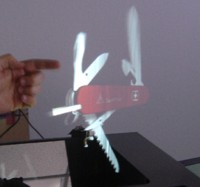Possible uses for this product include advertising, entertainment facilities, design prototyping, teleconferencing etc. Obviously the applications for such a product are endless. Most importantly it may convince my wife to finally allow the purchase of the Brooke Burke Swimsuit calendar for testing purposes! This of course relies heavily on pricing (TBD) and other more, um, personal matters.
Apparently the product is ready for release; visit the product page here which looks like its being updated right now.
Visit the IO2TECHNOLOGY company homepage here.
